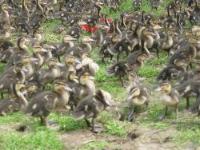Mallards: Our wild-colored mallards are kept in aviaries like the pheasants. Through a precise selection in the parent animals, which are regularly supplemented by foreign-blooded drakes, we achieve a very low false color rate. Our ducks are not trimmed and not docked, so they are always able to fly, which they also train in large aviaries. Parents also have the opportunity to swim and dive. Our wild-colored young mallards are raised in large, special duck aviaries with a pond. If the weather is good, you can leave the warm stable and bask in the sun from the 3rd day. As a rule, from the second week of life onwards, they are left completely to the outdoor climate for hardening. As a result, the plumage is well greased and they take on your waters without further ado. The time between the 5th and 6th week of life is ideal for release, as they are already feathered but do not yet fly enough to be able to move far away from your biotopes. In this week age, our young mallards are regularly available from around the end of May. General: Mallards are up to 58 centimeters long, their wingspan can be up to 95 centimeters. The male wears his plain dress between July and August and often looks confusingly similar to the female. Only the color of the beak can be used to determine the sex during this time, because the male's beak is still clearly yellow with a tinge of green, while the female's beak looks orange. The female has a brown-gray speckled color, which means that they are well camouflaged on land. Mallards have around 10,000 down and cover feathers that protect them from the wet and cold. They always grease this plumage so that no water penetrates through the plumage. The gland at the base of the tail provides the fat. The duck picks up the fat with its beak and strokes it in its plumage. The duck is carried on the water by an air cushion. The air stays between the down feathers and the cover feathers close the down. Together with the fat cushion under the skin, the enclosed air layer prevents body heat from being lost and the duck cooling down. Foxes, raccoons and birds of prey are natural enemies of mallards; Wandering rats and martens are mainly targeting ducklings. In the wild, ducks can live for 10 to 15 years. The mallard is a very callable duck. Males and females have different calls. A muffled "räb" is characteristic of the drake, which they sometimes hear in a row as "rääb-räb-räb-räb" with a decreasing pitch and volume. There are similar calls in females, but they sound more like "wak wak wak" or "wäk wäk wäk". The mallard repertoire also includes some instrumental sounds. This includes the matt ringing "wich wich wich ...", which is characteristic of the flight and is generated with the wings. The current name Mallard did not become the usual German name until the 20th century, in older literature it was also referred to as March duck [1]. The current name can be understood as an indication of their breeding grounds, which include pastures, willow bushes or brushwoods that are set on stick. Mallards do not breed on them often, but the behavior is so striking for a species of duck that it developed into the name that is common today. For a long time the name wild duck was more common, which is an unsatisfactory term from an ornithological point of view, since this name also applies to all other wild ducks across all species. This term is still used in the hunter's language, and a mallard duck is usually also prepared in a restaurant for wild duck dishes. There are significant individual, but also population-specific differences in the course of the moult. It can start in mid-May and ends regularly in August at the latest. For females, the Schwingenmauser takes place in September and the change of small plumage in breast dress between October and November.
Mallards
Copyright © All rights reserved.









